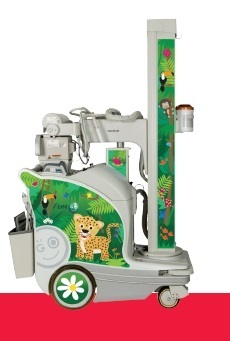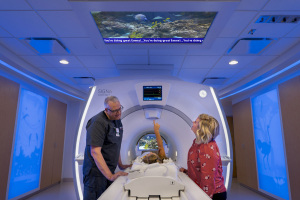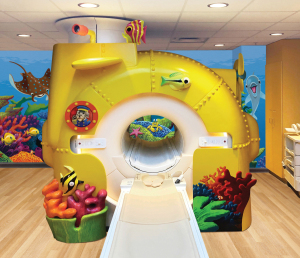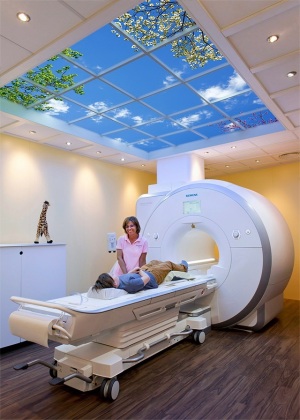Tackling pediatric fears of medical imaging
March 08, 2021
by John R. Fischer, Senior Reporter
For all patients, but children in particular, the experience of an MR scan can be pretty scary. There’s the noise, there’s the narrow bore, there’s the length of time staying perfectly still, and there’s the knowledge that some health issue needs investigating. This fear, however, can often be offset with a number of technological features and solutions designed to relax the patient in ways that enable scans to run smoothly and produce quality diagnostic images.
Michael Hemmerly, chief sales officer for PDC, a company that provides Caring MR Suites that convert the imaging atmosphere into something fantastical, knows the value of these capabilities professionally and personally. When his daughter arrived to undergo an MR scan, she was terrified, but when the lights turned pink and her favorite Disney movie, Frozen, began to play above the MR table, the mood in the room transformed.
“The smile on my daughter’s face at that moment was priceless, and she couldn’t wait to jump on the MR table,” Hemmerly told HCB News. “I had never seen her so excited in a hospital before.”
Fear of the unknown
Anxious patients are less likely to stay still during an MR scan. This motion can create artifacts that degrade the quality of the exam, leading to the need for a rescan and delaying other patients in line for their appointments. In extreme cases, children may have to be sedated, which increases the length of time for exams and comes with additional costs and safety concerns.
“Patient comfort is a worthwhile investment because it can help reduce the need for extra exposure to radiation, reduce the amount of staff needed to help hold, and reduce the need for anesthesia or sedation for procedures in the pediatric environment,” said Gloria Mendez, child life specialist for radiology, and Leida Rivera-Haddock, lead radiography tech at Nemours Children’s Hospital. “Investing in patient comfort will ultimately help save money and time as a department.”
For the comfort of their own patients, Nemours performs scans on dolls and stuffed animals to show patients how it’s done. Among the scanners they use are Fujifilm’s FDR Go PLUS, a portable digital X-ray system which comes with the option for several choices of kid-friendly graphic decals to make the equipment less intimidating, and its FDR D-EVO detectors, which have antibacterial coating, including one in 24x30 cm size for a just-right fit into the built-in trays underneath the isolettes in the NICU. This fit helps keep the babies from being disrupted when undergoing scans, they said.
“Naturally every part of the patient (and parent) experience comes into play including how comfortable they were made to feel during their exams and how well the exam minimized discomfort, which can also be affected by speed and accuracy of acquiring images,” said Robert Fabrizio, director of strategic marketing for medical imaging systems at FUJIFILM Medical Systems USA Inc. “Systems that are easy to operate, with automated optimization, help the technologist focus more attention on keeping the patient and parent(s) at ease.”
Let’s get this over with
The aim of any pediatric radiologist is to produce a quality scan as fast as possible. The sooner they do this, the sooner the child can get out of the scanner and relax. As a result, many providers look for scanners and technologies that speed up exams without decreasing the quality, such as Siemens’ GOBrain protocol, an accelerated MR exam that acquires images in five minutes with just the push of a button. In a recent pilot study of children under eight, Emory University School of Medicine and Children’s Healthcare of Atlanta (CHOA) found using GOBrain spared 70% of participants from being sedated.
“That to me is just phenomenal when we can take away the need to administer medication, perform venipuncture or intubate a child by 70%, not just in the time and cost savings from the healthcare side of it but to calm our patients enough so they can undergo this study that would allow our physicians to appropriately follow up with care,” said Jackie Morley, product manager – MRI Marketing for Siemens Healthineers North America.
Siemens also speeds up scanning of the neck and head with its Pediatric 16 coil which, when combined with its flexible coils, enables whole-body imaging while keeping children from feeling heaviness that could cause discomfort and result in unwanted movements and abandoned scans.
Seeing is believing
Altering an imaging suite’s appearance can transport children (and in some cases, adult patients) into calm and relaxing environments. Character Farms does this by camouflaging and blending the room’s scanning equipment, walls, floors, and ceilings into the background of beaches, nature settings and underwater paradises. The idea, according to Mark Sullivan, founder and president of Character Farms, is to distract them.
“For children, we create playful, imaginative and colorful places that will draw their attention away from any equipment and the typical sterile, medical environment,” he said. “For adults, we create a soothing and calming place that instantly helps put them at ease.”
This approach can be enhanced by incorporating visuals, noise effects and games that can bring a feeling of excitement to the imaging experience. GE Healthcare’s Pediatric Adventure Series, for instance, can make a patient feel like they’re part of an underwater expedition where they have to hold still so as not to bump into the coral, thereby preventing them from moving during the scan. “If the story makes sense to the child, they are more willing to play along,” said Mark Ciesko, Americas studio manager for global design at GE Healthcare.
Resonance Technology also uses visual effects to distract children. Its immersive 3D 50 inch LCD monitor, for instance, sits on the back of the MR scanner, with patients able to view image through a reflective mirror that pops into the tunnel of the scanner. This reduces claustrophobia and the need to sedate patients, according to company president, Mokhtar Ziarati. “The loud noise, tight space, dark tunnel, claustrophobia, and long scan times are all pretty scary to a child, let alone a sick child. To circumvent these issues, sedation has been the solution to scan kids. But using anesthesia has its own risks and associated problems, and is scary for the parents. Hence, methods that enable the option of imaging without sedation could increase patient safety and reduce associated costs.”
Audio is just as important to consider, as the loud noises of MR scanners can be unsettling. Effectively blocking out this sound can relax patients and make them feel more comfortable during the exam. “Our headphones are designed with SOUND+ Acoustic Enhancing Tubing. This enables the patient to more clearly hear the technologist’s instructions as well as the comforting music that relaxes them,” said Steve Loiacono, director of sales for healthcare at AVID Products, in regard to the company’s MR Safe headphones.
Sky Factory utilizes ceiling applications known as SkyCeilings that appear to the viewer as though they are looking at the open sky. In this way, the patient can experience the tranquility of open spaces at a time when they might otherwise be feeling very much boxed in.
“To calm a child, it is much more important to integrate their mind and body, rather than supply external interference,” said David Navarrete, director of research initiatives and accredited education for Sky Factory. “This is the reason why a view to nature (and particularly the sky) is so effective in dispelling stress and anxiety; it releases an automatic relaxation response.”
Preparation is key
To reduce anxiety, many providers seek to educate children prior to their scans. Philips’ Kittenscanner, for instance, enables pediatric patients to learn about the exam and machinery with a smaller version of a CT or MR scanner. The child can scan a toy, with a display showing them the insides of the figure, how the scanner works and why the exam is needed. This enables the patient to understand why they need a scan themselves and how the process works, in a kid-friendly manner.
“This distraction helps them minimize or eliminate scary thoughts and makes them more in control of the situation,” Werner Satter, GM of Healthcare Experience Solutions at Philips, told HCB News. “This can have a very calming effect.”
Another tactic is to include the child in setting up for the exam, according to Glen Nicholson, worldwide product manager for mobile solutions at Carestream. “Our DR tables all lower to a level that is easy for young patients to get onto themselves, allowing them to be a part of and assist with their exam.”
In addition, the company’s R/F solution, the DRX-Excel Plus, features ambient lighting that gently scrolls through the colors of the rainbow and allows the site to play soothing music during the exam. It also has pediatric-friendly side panels on its mobile solutions, the DRX-Revolution and DRX-Revolution Nano, for further comfort. “Capturing an image as quickly as possible, having the system move around the patient rather than having to move the patient, and being able to assure the patient (and their family members) that the lowest possible X-ray dose is being used — these are all things that allow the technologist to reassure the patient,” said Nicholson.
With transitions to value-based and more personalized care, these technologies are continuing to evolve to ensure patients feel safe and comfortable. More innovations utilizing artificial intelligence, virtual simulations and entertainment are expected to ensure both adult and pediatric patients undergo scanning in a fast, secure and relaxed manner so that clinicians can retrieve the quality diagnostic scans they need to treat and cure their patients.
Michael Hemmerly, chief sales officer for PDC, a company that provides Caring MR Suites that convert the imaging atmosphere into something fantastical, knows the value of these capabilities professionally and personally. When his daughter arrived to undergo an MR scan, she was terrified, but when the lights turned pink and her favorite Disney movie, Frozen, began to play above the MR table, the mood in the room transformed.
“The smile on my daughter’s face at that moment was priceless, and she couldn’t wait to jump on the MR table,” Hemmerly told HCB News. “I had never seen her so excited in a hospital before.”
Fear of the unknown
Anxious patients are less likely to stay still during an MR scan. This motion can create artifacts that degrade the quality of the exam, leading to the need for a rescan and delaying other patients in line for their appointments. In extreme cases, children may have to be sedated, which increases the length of time for exams and comes with additional costs and safety concerns.
“Patient comfort is a worthwhile investment because it can help reduce the need for extra exposure to radiation, reduce the amount of staff needed to help hold, and reduce the need for anesthesia or sedation for procedures in the pediatric environment,” said Gloria Mendez, child life specialist for radiology, and Leida Rivera-Haddock, lead radiography tech at Nemours Children’s Hospital. “Investing in patient comfort will ultimately help save money and time as a department.”
For the comfort of their own patients, Nemours performs scans on dolls and stuffed animals to show patients how it’s done. Among the scanners they use are Fujifilm’s FDR Go PLUS, a portable digital X-ray system which comes with the option for several choices of kid-friendly graphic decals to make the equipment less intimidating, and its FDR D-EVO detectors, which have antibacterial coating, including one in 24x30 cm size for a just-right fit into the built-in trays underneath the isolettes in the NICU. This fit helps keep the babies from being disrupted when undergoing scans, they said.
“Naturally every part of the patient (and parent) experience comes into play including how comfortable they were made to feel during their exams and how well the exam minimized discomfort, which can also be affected by speed and accuracy of acquiring images,” said Robert Fabrizio, director of strategic marketing for medical imaging systems at FUJIFILM Medical Systems USA Inc. “Systems that are easy to operate, with automated optimization, help the technologist focus more attention on keeping the patient and parent(s) at ease.”
Let’s get this over with
The aim of any pediatric radiologist is to produce a quality scan as fast as possible. The sooner they do this, the sooner the child can get out of the scanner and relax. As a result, many providers look for scanners and technologies that speed up exams without decreasing the quality, such as Siemens’ GOBrain protocol, an accelerated MR exam that acquires images in five minutes with just the push of a button. In a recent pilot study of children under eight, Emory University School of Medicine and Children’s Healthcare of Atlanta (CHOA) found using GOBrain spared 70% of participants from being sedated.
“That to me is just phenomenal when we can take away the need to administer medication, perform venipuncture or intubate a child by 70%, not just in the time and cost savings from the healthcare side of it but to calm our patients enough so they can undergo this study that would allow our physicians to appropriately follow up with care,” said Jackie Morley, product manager – MRI Marketing for Siemens Healthineers North America.
Siemens also speeds up scanning of the neck and head with its Pediatric 16 coil which, when combined with its flexible coils, enables whole-body imaging while keeping children from feeling heaviness that could cause discomfort and result in unwanted movements and abandoned scans.
Seeing is believing
Altering an imaging suite’s appearance can transport children (and in some cases, adult patients) into calm and relaxing environments. Character Farms does this by camouflaging and blending the room’s scanning equipment, walls, floors, and ceilings into the background of beaches, nature settings and underwater paradises. The idea, according to Mark Sullivan, founder and president of Character Farms, is to distract them.
“For children, we create playful, imaginative and colorful places that will draw their attention away from any equipment and the typical sterile, medical environment,” he said. “For adults, we create a soothing and calming place that instantly helps put them at ease.”
This approach can be enhanced by incorporating visuals, noise effects and games that can bring a feeling of excitement to the imaging experience. GE Healthcare’s Pediatric Adventure Series, for instance, can make a patient feel like they’re part of an underwater expedition where they have to hold still so as not to bump into the coral, thereby preventing them from moving during the scan. “If the story makes sense to the child, they are more willing to play along,” said Mark Ciesko, Americas studio manager for global design at GE Healthcare.
Resonance Technology also uses visual effects to distract children. Its immersive 3D 50 inch LCD monitor, for instance, sits on the back of the MR scanner, with patients able to view image through a reflective mirror that pops into the tunnel of the scanner. This reduces claustrophobia and the need to sedate patients, according to company president, Mokhtar Ziarati. “The loud noise, tight space, dark tunnel, claustrophobia, and long scan times are all pretty scary to a child, let alone a sick child. To circumvent these issues, sedation has been the solution to scan kids. But using anesthesia has its own risks and associated problems, and is scary for the parents. Hence, methods that enable the option of imaging without sedation could increase patient safety and reduce associated costs.”
Audio is just as important to consider, as the loud noises of MR scanners can be unsettling. Effectively blocking out this sound can relax patients and make them feel more comfortable during the exam. “Our headphones are designed with SOUND+ Acoustic Enhancing Tubing. This enables the patient to more clearly hear the technologist’s instructions as well as the comforting music that relaxes them,” said Steve Loiacono, director of sales for healthcare at AVID Products, in regard to the company’s MR Safe headphones.
Sky Factory utilizes ceiling applications known as SkyCeilings that appear to the viewer as though they are looking at the open sky. In this way, the patient can experience the tranquility of open spaces at a time when they might otherwise be feeling very much boxed in.
“To calm a child, it is much more important to integrate their mind and body, rather than supply external interference,” said David Navarrete, director of research initiatives and accredited education for Sky Factory. “This is the reason why a view to nature (and particularly the sky) is so effective in dispelling stress and anxiety; it releases an automatic relaxation response.”
Preparation is key
To reduce anxiety, many providers seek to educate children prior to their scans. Philips’ Kittenscanner, for instance, enables pediatric patients to learn about the exam and machinery with a smaller version of a CT or MR scanner. The child can scan a toy, with a display showing them the insides of the figure, how the scanner works and why the exam is needed. This enables the patient to understand why they need a scan themselves and how the process works, in a kid-friendly manner.
“This distraction helps them minimize or eliminate scary thoughts and makes them more in control of the situation,” Werner Satter, GM of Healthcare Experience Solutions at Philips, told HCB News. “This can have a very calming effect.”
Another tactic is to include the child in setting up for the exam, according to Glen Nicholson, worldwide product manager for mobile solutions at Carestream. “Our DR tables all lower to a level that is easy for young patients to get onto themselves, allowing them to be a part of and assist with their exam.”
In addition, the company’s R/F solution, the DRX-Excel Plus, features ambient lighting that gently scrolls through the colors of the rainbow and allows the site to play soothing music during the exam. It also has pediatric-friendly side panels on its mobile solutions, the DRX-Revolution and DRX-Revolution Nano, for further comfort. “Capturing an image as quickly as possible, having the system move around the patient rather than having to move the patient, and being able to assure the patient (and their family members) that the lowest possible X-ray dose is being used — these are all things that allow the technologist to reassure the patient,” said Nicholson.
With transitions to value-based and more personalized care, these technologies are continuing to evolve to ensure patients feel safe and comfortable. More innovations utilizing artificial intelligence, virtual simulations and entertainment are expected to ensure both adult and pediatric patients undergo scanning in a fast, secure and relaxed manner so that clinicians can retrieve the quality diagnostic scans they need to treat and cure their patients.




